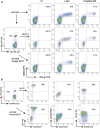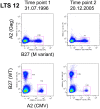Innate and Adaptive Immunity in Long-Term Non-Progression in HIV Disease
- PMID: 23630526
- PMCID: PMC3633949
- DOI: 10.3389/fimmu.2013.00095
Innate and Adaptive Immunity in Long-Term Non-Progression in HIV Disease
Abstract
Long-term non-progressors (LTNP) were identified after 10-15 years of the epidemic, and have been the subject of intense investigation ever since. In a small minority of cases, infection with nef/3'LTR deleted attenuated viral strains allowed control over viral replication. A common feature of LTNP is the readily detected proliferation of CD4 T-cells in vitro, in response to p24. In some cases, the responding CD4 T-cells have cytotoxic effector function and may target conserved p24 epitopes, similar to the CD8 T-cells described below. LTNP may also carry much lower HIV DNA burden in key CD4 subsets, presumably resulting from lower viral replication during primary infection. Some studies, but not others, suggest that LTNP have CD4 T-cells that are relatively resistant to HIV infection in vitro. One possible mechanism may involve up-regulation of the cell cycle regulator p21/waf in CD4 T-cells from LTNP. Delayed progression in Caucasian LTNP is also partly associated with heterozygosity of the Δ32 CCR5 allele, probably through decreased expression of CCR5 co-receptor on CD4 T-cells. However, in approximately half of Caucasian LTNP, two host genotypes, namely HLA-B57 and HLA-B27, are associated with viral control. Immunodominant CD8 T-cells from these individuals target epitopes in p24 that are highly conserved, and escape mutations have significant fitness costs to the virus. Furthermore, recent studies have suggested that these CD8 T-cells from LTNP, but not from HLA-B27 or HLA-B57 progressors, can cross-react with intermediate escape mutations, preventing full escape via compensatory mutations. Humoral immunity appears to play little part in LTNP subjects, since broadly neutralizing antibodies are rare, even amongst slow progressors. Recent genome-wide comparisons between LTNP and progressors have confirmed the HLA-B57, HLA-B27, and delta32 CCR5 allelic associations, plus indicated a role for HLA-C/KIR interactions, but have not revealed any new genotypes so far. Nevertheless, it is hoped that studying the mechanisms of intracellular restriction factors, such as the recently identified SAMHD1, will lead to a better understanding of non-progression.
Keywords: HIV-1; cell-mediated immunity; cytotoxic T lymphocytes; elite controllers; long-term non-progressors.
Figures


References
LinkOut - more resources
Full Text Sources
Other Literature Sources
Research Materials
Miscellaneous

